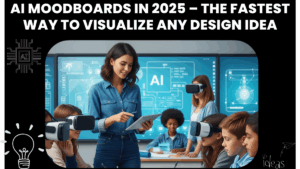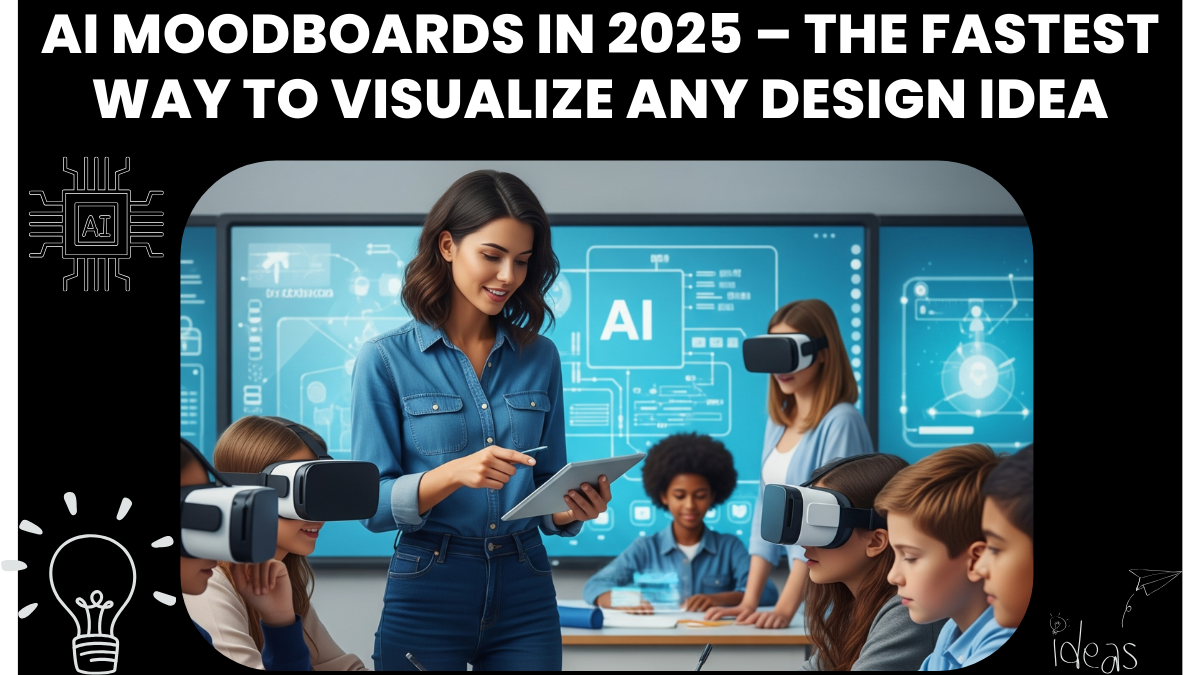In the world of design, visual communication is everything. Whether you’re pitching an idea to a client, experimenting with interiors, or planning a fashion line, the ability to bring concepts to life quickly can make all the difference. That’s why AI moodboards 2025 have become one of the hottest tools for creatives worldwide. With advanced design visualization tools, designers can now generate moodboards in minutes instead of spending hours manually sourcing images, layouts, and color palettes.
This trend is reshaping industries from interior design and fashion to marketing and branding. AI-driven platforms use generative algorithms, natural language processing, and style-matching to deliver instant visuals that capture the essence of a project. The result? Faster workflows, better presentations, and more polished creativity.

What Are AI Moodboards?
A moodboard is a collage of images, colors, textures, and typography that communicates the theme or mood of a project. Traditionally, designers spent hours collecting references from magazines, stock photo sites, or Pinterest. In 2025, AI moodboards automate this process. You simply type a description—such as “modern boho living room with neutral tones”—and the AI generates a visual board with matching photos, textures, and layouts.
Unlike static boards of the past, AI-generated moodboards are dynamic. They can adapt to revisions, suggest alternatives, and even match client preferences automatically.
Why AI Moodboards Are Game-Changers in 2025
The growing reliance on design visualization tools reflects the demand for speed and accuracy in the creative industry. Here’s why AI moodboards are so impactful:
-
Time Efficiency: What once took hours can now be completed in minutes.
-
Personalization: AI learns your style and offers tailored suggestions.
-
Diversity of Options: Generates multiple variations for comparison.
-
Collaboration: Easy sharing and editing makes teamwork smoother.
-
Client Approval: Clients visualize ideas instantly, reducing miscommunication.
These benefits make AI moodboards a must-have tool for professionals in 2025.
Top AI Moodboard Tools in 2025
A range of platforms are leading the AI moodboard revolution. Some of the most popular include:
-
Canva AI Moodboards: Offers drag-and-drop simplicity combined with generative AI for quick visual drafts.
-
Milanote AI: Known for creative brainstorming, now enhanced with AI for instant moodboard generation.
-
Pinterest AI Boards: Automatically curates content based on keywords and visual similarities.
-
InteriorAI: Focused on home design, generating furniture, colors, and layouts instantly.
-
FashionAI Boards: Tailored for apparel designers, helping visualize fabric combinations and seasonal trends.
These platforms serve professionals across industries, from architects to content creators.
How AI Moodboards Are Used Across Industries
The versatility of AI moodboards 2025 is evident in their wide applications:
-
Interior Design: Designers create boards for clients showing room concepts, furniture layouts, and lighting ideas.
-
Fashion: Moodboards combine textures, fabrics, and patterns for seasonal collections.
-
Marketing: Agencies visualize campaign aesthetics, from color palettes to ad layouts.
-
Branding: Startups use moodboards to define logos, fonts, and brand colors.
-
Education: Design students rely on AI tools to learn faster and present ideas creatively.
This cross-industry adoption proves that AI moodboards are more than just a trend—they are becoming a professional standard.
Benefits for Designers and Clients
The impact of design visualization tools goes beyond speed:
-
For Designers: Saves time, reduces creative blocks, and allows more focus on innovation.
-
For Clients: Provides instant clarity, enabling quicker approvals and fewer revisions.
-
For Businesses: Shortens project timelines and improves customer satisfaction.
AI moodboards thus create a win-win situation for both creators and clients.
Challenges and Limitations
While AI moodboards are powerful, they are not without challenges:
-
Over-Reliance on AI: Designers risk losing personal creative touch if they depend too much on algorithms.
-
Accuracy Issues: Sometimes AI misinterprets prompts, generating irrelevant visuals.
-
Cost: Premium AI platforms may be expensive for freelancers and small studios.
-
Learning Curve: Adapting to AI workflows requires some initial effort.
Despite these issues, most professionals agree that the benefits far outweigh the drawbacks.
The Future of Moodboarding
In the coming years, moodboarding will evolve even further. With AR and VR integration, clients may soon “walk through” AI-generated moodboards in immersive 3D environments. AI will also become more predictive, anticipating client needs before they’re even expressed.
For Indian designers, this is particularly promising. As interior design and fashion markets expand, AI moodboards allow them to compete globally by delivering world-class presentations instantly.
Final Thoughts
The rise of AI moodboards 2025 reflects the growing demand for efficiency and creativity in design. By combining speed with customization, these design visualization tools empower designers to communicate ideas more effectively and clients to make decisions faster.
In 2025, moodboarding is no longer a slow, manual process—it’s a smart, AI-powered tool thClick here to know more.at accelerates creativity. For designers across industries, adopting AI moodboards is not just about keeping up with trends but about staying ahead in a fast-changing world.
FAQs
What is an AI moodboard?
It is a digitally generated visual board created using AI algorithms based on text prompts or design themes.
Which industries use AI moodboards in 2025?
Interior design, fashion, marketing, branding, and education are the top sectors using them.
Are AI moodboards replacing human creativity?
No, they assist designers by speeding up workflows, but human input and style remain essential.
What are the best AI moodboard tools in 2025?
Canva AI Moodboards, Milanote AI, Pinterest AI Boards, and InteriorAI are among the most popular.
Click here to know more.
